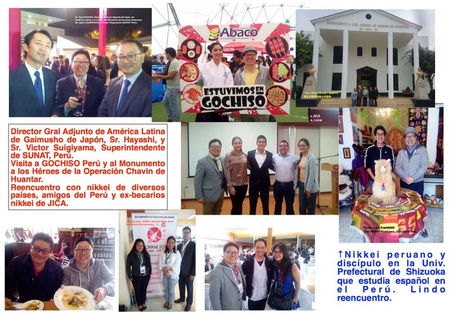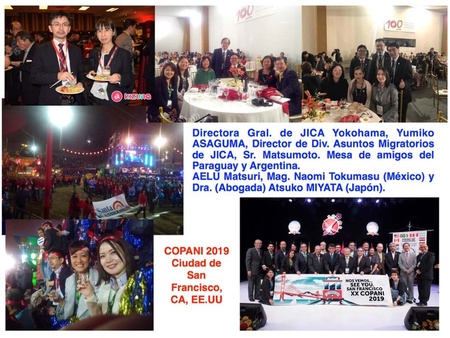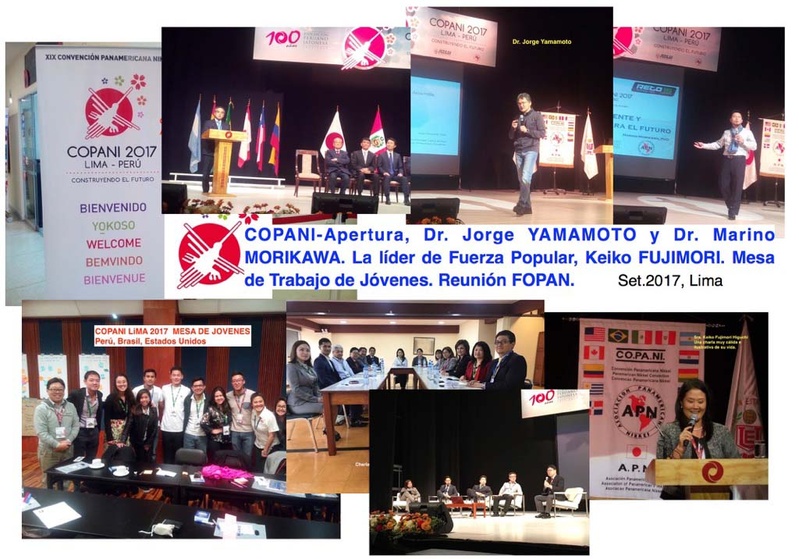The 19th Pan-American Japanese Convention (COPANI - Convención Panamericana Nikkei) was held in Lima, Peru from November 2nd to 5th, 20171, and at the same time, a ceremony was held to commemorate the 100th anniversary of the Peruvian Japanese Association (APJ - Asociación Peruano Japonesa) 2 .
This year's COPANI featured a variety of programs under the theme of "Building the Future." There were numerous lectures, including a keynote speech by economist Luis Baba Nakao on current global economic trends, as well as workshops on topics such as Nikkei identity and immigration, Japanese culture and the Japanese language, the achievements of Nikkei education, business and mutual aid association activities, the role of women and social welfare, and youth leadership and current values. I also spoke about the Japanese government's new policy for cooperation with the Nikkei community in Latin America, its future possibilities and challenges, 3 and held talks and discussions with mid-level leaders from Argentina, Brazil, Mexico, and Peru. Other wonderful events included a reception at the Japanese Embassy in Lima, the 100th anniversary party of the Peruvian Association of Japanese, and the AELU Festival.
The speech that attracted the most attention was given by Keiko Fujimori, leader of the opposition party Fuerza Popular. Fujimori does not usually attend many events held by Japanese organizations, but she gladly accepted the invitation to speak this time as Japanese leaders and dignitaries from the Americas and Japan were in attendance. In her speech, she spoke about the image of Japanese people that she painted based on her own family experiences and the future role of Japanese people in society. Her speech was delivered in a very calm atmosphere, and she sent a warm message to the next generation of Japanese people. It was undoubtedly a valuable experience for the participants.
Two other Japanese experts also gave lectures: Jorge Yamamoto4, a social scientist and psychology PhD holder who is researching the relationship between improving quality of life and happiness, and Marino Morikawa5 , who holds a PhD in Environmental Science from the Graduate School of Life Sciences at the University of Tsukuba.
Yamamoto stated that to understand happiness in a society full of contradictions and diversity, it is necessary to consider how regional standards of living bring about differences in the value of happiness, and he offered an insightful analysis of the Japanese community in Peru.
For Japanese Americans who have experienced discrimination, inequality, and sometimes even persecution, the idealized self-esteem they have developed in the process of pursuing happiness is a major obstacle. They tend to unconsciously become defensive, shut out criticism and advice from outside, and become intolerant. He warned that such "isolation" breeds ego, makes them self-centered, fossilizes the culture and behavior of Japanese Americans, and risks hindering coexistence and cooperation with local communities.
Peru's Japanese community is already in the third and fourth generation, and it seems that the mix of races has progressed and that integration into the local society is progressing. However, Japanese people who have relatively high incomes and belong to multiple Japanese organizations, mutual aid societies, Japanese hospitals, etc. tend to be indifferent to the disparities and inequal opportunities between them and those who are not. In light of this current situation, he ended his lecture with a strong message: "You can either become a full member of society or be disadvantaged (by self-exclusion) (O te integras o te jodes)," and these words left a strong impression on me.
Peru has the most mature Japanese community in South America. In the 1980s, a time when Peru was plagued by terrorism and economic stagnation, many Japanese went to Japan to work as dekasegi workers, and at one point, all Japanese organizations, including the Association of Japanese Peruvians in Peru and the Okinawa Prefectural Association (AOP) 6 , faced a crisis of survival due to a decline in membership. After that, with the help of remittances from around 60,000 dekasegi workers, the Japanese community was able to recover financially little by little. Furthermore, thanks to the success of various businesses run by Japanese people, Japanese organizations and mutual aid associations have made great strides organizationally. Perhaps Yamamoto hopes that the results of this development and the various values that Japanese people can be proud of will be given back more to Peruvian society, that is, to non-Japanese people.

Morikawa, a third-generation Japanese, gave a presentation on anti-pollution work in the El Cascajo, Chancay wetlands, where he spent his childhood, in the north of Lima. Morikawa started out by collecting trash left in the El Cascajo wetlands, and later, with the help of local residents, he succeeded in improving the wetlands' water quality using a purification system he developed himself. Currently, at the request of Peru's environmental administration, he is working to improve the water quality of Lake Titicaca, which is severely polluted by mine wastewater and domestic wastewater. Morikawa is always working together with local residents to improve their awareness, and this has earned him high praise.
A notable feature of this year's COPANI was the attendance of many important figures from Japan. Not only did Counsellor Hayashi of the Latin America and Caribbean Affairs Bureau of the Ministry of Foreign Affairs attend for the first time, representing the Japanese government, which places great importance on future relations between Japan and Latin America, but also Yumiko Asakuma, Director of the Yokohama International Center, and Matsumoto, Director of the Planning and Migration Division of the Latin America and Caribbean Department at JICA's headquarters, attended. Also in attendance were Katsuyuki Tanaka, Chairman of the Association of Japanese Overseas, and Professor Yukie Asaka of Nanzan University, as well as JICA volunteers for Japanese communities working in Peru and Argentina.
Participants are of diverse ages and occupations, but COPANI is a valuable opportunity for Japanese leaders and influential people from various countries to gather at once, and it is also a place that leads to strengthening relations between Japan and the Japanese communities in the Americas. What is important in such an opportunity is to understand the common challenges and success stories faced by each Japanese community, while also thinking together about what activities Japanese people are valued for in the local community, and what they can do in the future to live up to the trust and expectations of the local community. For me, COPANI is always a place where I can gain something, and this time was no exception, and my stay there was very meaningful.
The Peruvian Japanese Association, which is celebrating its 100th anniversary this year, has overcome many challenges up to now, but has effectively utilized its strong ties with Japan, and has improved its facilities with donations and cooperation from wealthy and influential people. Currently, the headquarters site is home to Peru's largest theater, and a general clinic and welfare center are also located nearby. In recent years, the association has also revived ties with Japanese groups in the regional cities of Pucallpa in Amazonia and Cusco, near Machu Picchu, and is jointly developing Japanese cultural projects and other programs. It is hoped that in the future, Japanese people from regional areas will also be able to take part in the Lima projects, and find it easier to participate in and apply for exchanges and training with Japan.
Everyone was blown away by the grandeur of the AELU Festival. After the delegations from each of the COPANI participating countries were shown to their VIP seats, Japanese singers performed one after another. What made a strong impression on me about the festival was that many of the officials, including the former chairpersons of various organizations, fulfilled their assigned roles as volunteers within the venue. The officials and wives of the women's division took care of everything, from distributing water and lunch boxes to coordinating the parade order and taking photos and videos. Participants from every country seemed unable to hide their amazement at how efficiently everything was done.
The participants must have been deeply moved and inspired. The next COPANI has been confirmed to be held in San Francisco, California, USA. It can be said that there are more new challenges and more fun to be had.

Notes:
1. COPANI 2017 Facebook This page contains photos and interview videos from COPANI.
2. The Japanese Peruvian Association's website and magazine, Kaikan , feature all the events.
3. On May 9, 2017, the report of the "Experts' Conference on Cooperation with Japanese Communities in Latin America" was submitted to Vice-Minister for Foreign Affairs Sonoura, and this report will be the basis for cooperation between Japan and Japanese communities in the future. The Japanese, Spanish, and Portuguese versions of the report are available on the following website.
4. Jorge Yamamoto's Facebook
Mr. Yamamoto's profile page at La Pontificia Universidad Católica del Perú
" The more material goals we have, the less valuable happiness becomes" (RPP News, March 7, 2018)
" Jorge Yamamoto: "Huancayo is the city that has the best images of felicity" " (RPPNoticia
5.Marino Morikawa's Facebook
Mr. Morikawa's profile page at the Graduate School of Tsukuba University
6. Association of Oceanians of Peru (AOP)
AOP Facebook
© 2018 Alberto J. Matsumoto







